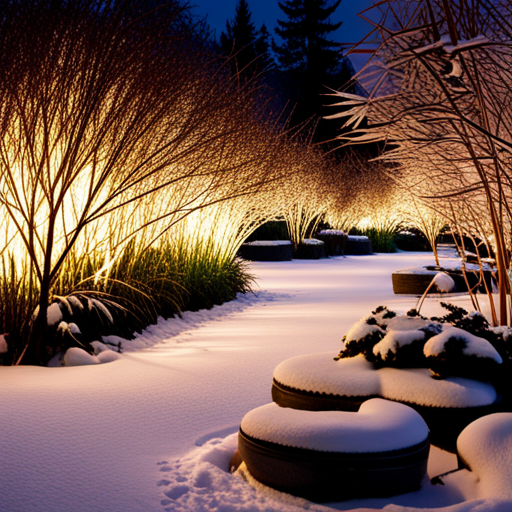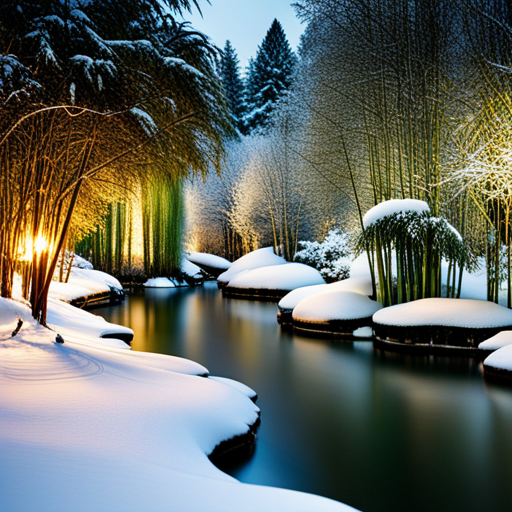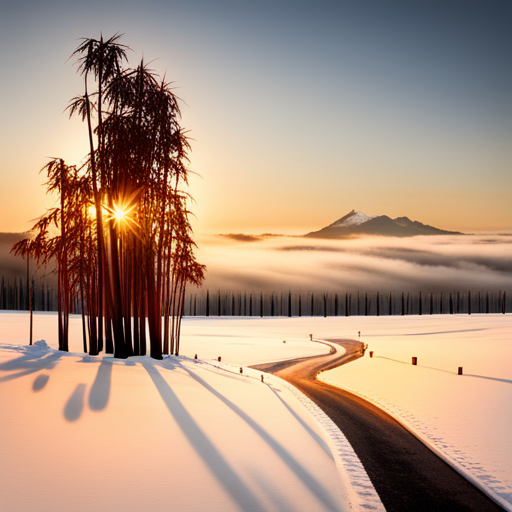Cold Hardy Bamboo Species for Zone 4 Gardens
Gardening in Zone 4 gardens with cold winter temperatures can present a challenge when it comes to finding suitable bamboo species. However, there are several running bamboo options that can thrive in these conditions.
One such species is Phyllostachys nuda, commonly known as Snow Bamboo. With its dark green canes and bright green leaves, this cold hardy bamboo may even remain evergreen in Zone 4b.
Another option is Phyllostachys Aureosulcata ‘Yellow Groove’, which features yellow and green striping coloration. While it forms a dense privacy screen and is visually appealing as a container specimen, it may lose some or all of its leaves during harsh Zone 4 winters.
Phyllostachys Bissetii is another versatile running bamboo that performs well in various conditions and is ideal for privacy screens, hedges, and container growing. However, it may experience foliage loss in winter.
Lastly, Phyllostachys heteroclada ‘Purpurata’, also known as Water Bamboo, is root hardy to Zone 4 and can survive in wet growing conditions. Although it loses all foliage in winter, it regrows new shoots in spring.
When cultivating bamboo in cold climates, it is crucial to understand your plant hardiness zone, select compatible species, choose a sheltered planting location, and apply generous mulching.
Contents
- 1 Our Highlighted Points
- 2 What can grow in Zone 4?
- 3 Cold Tolerant Bamboo Options
- 4 Tips for Growing in Cold Climates
- 5 Frequently Asked Questions
- 5.1 Can I grow clumping bamboo in Zone 4?
- 5.2 How tall does Phyllostachys nuda (Snow Bamboo) grow in Zone 4?
- 5.3 Does Phyllostachys Aureosulcata ‘Yellow Groove’ stay evergreen in Zone 4?
- 5.4 What is the foliage color of Phyllostachys Bissetii in Zone 4?
- 5.5 Is Phyllostachys heteroclada ‘Purpurata’ suitable for container growing in Zone 4?
Our Highlighted Points
- Phyllostachys nuda (Snow Bamboo) is a cold hardy running bamboo that stays evergreen in Zone 4b and grows 6 to 8 feet tall.
- Phyllostachys Aureosulcata ‘Yellow Groove’ is a running bamboo that forms a dense privacy screen and looks amazing as a container specimen, but may lose some or all of its leaves in Zone 4 winters. It grows about 8 feet tall in Zone 4.
- Phyllostachys Bissetii is a versatile running bamboo that is great for privacy screens, hedges, and container growing. It may lose foliage during winter in Zone 4 and reaches 8 feet tall.
– Phyllostachys heteroclada ‘Purpurata’ (Water Bamboo) is root hardy to Zone 4 and is great for privacy screens. It loses all foliage in winter but grows new shoots in spring. It is not suitable for container growing and can survive in wet growing conditions.
What can grow in Zone 4?

In Zone 4 gardens, Phyllostachys nuda (Snow Bamboo), Phyllostachys Aureosulcata ‘Yellow Groove’, and Phyllostachys Bissetii are cold hardy bamboo species that can grow well, although some may lose foliage during winter.
These bamboo species are considered to be the best plants for Zone 4 gardens due to their ability to withstand the harsh winter temperatures. However, it is important to note that they may experience leaf loss during this time.
To ensure successful growth in Zone 4, it is recommended to employ proper gardening techniques such as planting in a sheltered spot and mulching generously.
By following these guidelines, gardeners in Zone 4 can enjoy the beauty and benefits of these cold hardy bamboo species.
Cold Tolerant Bamboo Options

Phyllostachys nuda and Phyllostachys Aureosulcata ‘Yellow Groove’ are running bamboo varieties that are well-suited for cold climates. These cold hardy bamboo varieties are ideal for gardeners in Zone 4 who experience harsh winters.
Phyllostachys nuda, also known as Snow Bamboo, is a cold hardy running bamboo with dark green canes and bright green leaves. It may even stay evergreen in Zone 4b.
On the other hand, Phyllostachys Aureosulcata ‘Yellow Groove’ is a running bamboo with yellow and green striping coloration. Although it may lose some or all of its leaves during Zone 4 winters, it forms a dense privacy screen and looks stunning as a container specimen.
These bamboo varieties offer both aesthetic appeal and resilience, making them the best choices for cold climates.
Markdown List:nn1. Phyllostachys nuda (Snow Bamboo)nn2. Phyllostachys Aureosulcata ‘Yellow Groove’nn3. Cold hardy bamboo varieties best suited for harsh winters.
Tips for Growing in Cold Climates

To successfully cultivate bamboo in colder climates, it is important to consider the specific plant hardiness zone, choose appropriate varieties, select a sheltered planting location, and provide ample mulch for protection.
When it comes to mulching techniques, applying a thick layer of organic mulch around the base of the bamboo can help insulate the roots and protect them from freezing temperatures. This layer of mulch also helps to retain moisture, which is crucial for the plant’s survival during the winter months.
In terms of planting locations, it is recommended to choose a spot that is sheltered from strong winds and has well-drained soil. This will help to minimize the risk of cold damage and ensure the bamboo’s overall health and growth in Zone 4 gardens.
Read about taking care of hardy bamboo for zone 5 here.
Frequently Asked Questions
Can I grow clumping bamboo in Zone 4?
Clumping bamboo can be grown in Zone 4 gardens, but it requires careful maintenance. The best clumping bamboo varieties for cold climates include Fargesia robusta and Fargesia nitida, which are both cold hardy and suitable for Zone 4.
How tall does Phyllostachys nuda (Snow Bamboo) grow in Zone 4?
In zone 4, Phyllostachys nuda (Snow Bamboo) can grow to a height of 6 to 8 feet. To ensure optimal growth, it is important to provide the best growing conditions for Phyllostachys nuda in zone 4.
Does Phyllostachys Aureosulcata ‘Yellow Groove’ stay evergreen in Zone 4?
Phyllostachys aureosulcata ‘Yellow Groove’ may not stay evergreen in Zone 4. While it is a cold-hardy bamboo variety, the foliage of ‘Yellow Groove’ may be susceptible to winter damage and may lose some or all of its leaves during the cold season.
What is the foliage color of Phyllostachys Bissetii in Zone 4?
The foliage color of Phyllostachys bissetii in Zone 4 can vary, but it is primarily described as gray-green. When gardening with bamboo in Zone 4, it is important to consider various tips for success.
Is Phyllostachys heteroclada ‘Purpurata’ suitable for container growing in Zone 4?
Phyllostachys heteroclada ‘Purpurata’ is not suitable for container growing in Zone 4. However, for growing bamboo in containers in cold climates, it is best to choose cold hardy species and employ methods such as planting in a sheltered spot and generous mulching.

